Jigsaw puzzles from Japan
The Attic
Deleted puzzles
This page shows puzzles that are no longer available, just for historical curiosity, and for completeness.
In some cases puzzles are reissued with a different code number: if you have the old code number from somewhere, this page should show you the replacement (which may still be available).
1500 pieces
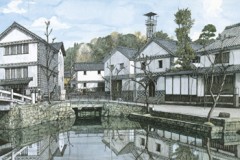 © Yoshida Keiji 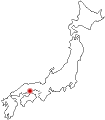
Warehouses, Kurashiki (Keiji)Warehouses cluster by the waterway in this beautifully preserved area of Kurashiki. These were run by the Tonya, the forerunner of Japan's famously beaurocratic distribution system. The architect's eye faithfully depicts details of the buildings, while the artist's produces a fine composition. Born in 1930, in Gifu Prefecture, Yoshida Keiji graduated in 1952 from what is now the Tokyo University of the Arts, and trained as an architect. He was a joint founder of Rengousekkeisha Ichigaya Architects in Tokyo, and in addition has held academic appointments and written widely, particularly on wooden building construction and aspects of townscape. He is active in the movement to preserve the traditional Japanese townscape, which features in his many "travel sketches," together with views from wider travel around the world. Yoshida is his family name.
 Permanently unavailable Permanently unavailableAn Epoch puzzle: 1500 pieces; 750 x 500 mm (30" x 20") Code: E15043 (15-043 on package) Retail price ¥3000 |
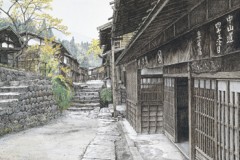 © Yoshida Keiji 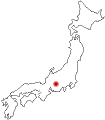
Tsumago post town (Keiji)A faithful representation of the classic view at Tsumago. As the inscription on the noren tells us, this is station 43 on the old Nakasendo road where it begins to climb over the Japan Alps on the long journey from Kyoto to Tokyo. The noren is the short curtain hung outside the building on the right (meaning "We're open!") –this is the famous Matsushiroya inn, one of the hostelries catering to weary travellers on what must have been an arduous journey. Born in 1930, in Gifu Prefecture, Yoshida Keiji graduated in 1952 from what is now the Tokyo University of the Arts, and trained as an architect. He was a joint founder of Rengousekkeisha Ichigaya Architects in Tokyo, and in addition has held academic appointments and written widely, particularly on wooden building construction and aspects of townscape. He is active in the movement to preserve the traditional Japanese townscape, which features in his many "travel sketches," together with views from wider travel around the world. Yoshida is his family name.
 Permanently unavailable Permanently unavailableAn Epoch puzzle: 1500 pieces; 750 x 500 mm (30" x 20") Code: E15044 (15-044 on package) Retail price ¥3000 |
1000 pieces
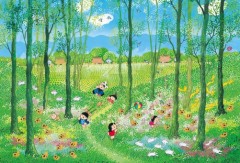 © Ikehara Shōji Children of spring (Ikehara)A clutch of children wander through the woods, one carrying a pair of takeuma stilts, an older girl carrying the baby, no doubt while her mother works in the fields. The woods are full of nostalgically remembered animals, rabbits, raccoon dogs, and foxes... Born in Kagawa Prefecture (Shikoku) in 1939, Ikehara is an artist specialising in illustration for children's story book, but whose work has also appeared in TV manga versions of traditional tales, and on postage stamps. His style is simple, but effective. He signs his pictures with a hand-drawn "seal", which is hard to decipher, but looks like the second character of his given name.  Permanently unavailable Permanently unavailableDiscontinued November 2020 A Beverly puzzle: 1000 pieces; 720 x 490 mm (28" x 19") Code: B61384 (61-384 on package) Retail price ¥3000 |
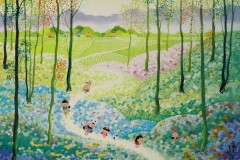 © Ikehara Shôji Musashino Mandala (Ikehara)A straggle of children wend their playful way through the woods, surrounded by various cute animals. Beyond are fields (not paddies; perhaps tea?), a clutch of houses, and distant mountains. Musashino is the old name for the area west of Tokyo, so perhaps this "mandala" is not the usual representation of a Buddhist other world, but just a childhood memory. Born in Kagawa Prefecture (Shikoku) in 1939, Ikehara is an artist specialising in illustration for children's story book, but whose work has also appeared in TV manga versions of traditional tales, and on postage stamps. His style is simple, but effective. He signs his pictures with a hand-drawn "seal", which is hard to decipher, but looks like the second character of his given name.  Permanently unavailable Permanently unavailableAn Epoch puzzle: 1000 pieces; 750 x 500 mm (30" x 20") Code: E11143 (11-143 on package) Retail price ¥3000 |
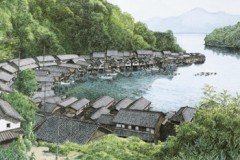 © Yoshida Keiji 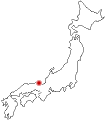
Ine fishing village (Keiji)An exceptionally picturesque fishing village on the Japan sea coast, Ine has houses of an unusual construction, with a boathouse built directly into the seaward side, which the artist has portrayed in loving detail. Born in 1930, in Gifu Prefecture, Yoshida Keiji graduated in 1952 from what is now the Tokyo University of the Arts, and trained as an architect. He was a joint founder of Rengousekkeisha Ichigaya Architects in Tokyo, and in addition has held academic appointments and written widely, particularly on wooden building construction and aspects of townscape. He is active in the movement to preserve the traditional Japanese townscape, which features in his many "travel sketches," together with views from wider travel around the world. Yoshida is his family name.
 Permanently unavailable Permanently unavailableAn Epoch puzzle: 1000 pieces; 750 x 500 mm (30" x 20") Code: E11303 (11-303 on package) Retail price ¥3000 |
 © Yoshida Keiji 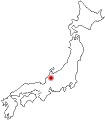
Shirakawa springtime (Keiji)A springtime view of Shirakawa, the well-preserved village in the northern Alps, where the houses were built for extended families of up to forty people. Watercourses weave among the houses to supply the paddy fields. Born in 1930, in Gifu Prefecture, Yoshida Keiji graduated in 1952 from what is now the Tokyo University of the Arts, and trained as an architect. He was a joint founder of Rengousekkeisha Ichigaya Architects in Tokyo, and in addition has held academic appointments and written widely, particularly on wooden building construction and aspects of townscape. He is active in the movement to preserve the traditional Japanese townscape, which features in his many "travel sketches," together with views from wider travel around the world. Yoshida is his family name.
 Permanently unavailable Permanently unavailableAn Epoch puzzle: 1000 pieces; 500 x 750 mm (20" x 30") Code: E11304 (11-304 on package) Retail price ¥3000 |
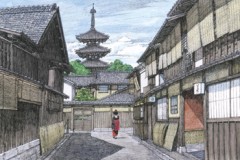 © Yoshida Keiji 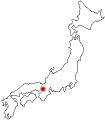
Gion, Kyoto (Keiji)A corner of the historical entertainment area of Kyoto, as a Maiko, or apprentice Geisha entertainer makes her way to her teahouse. The history of this area goes back a thousand years, and the buildings are now all preserved in their traditional state. Born in 1930, in Gifu Prefecture, Yoshida Keiji graduated in 1952 from what is now the Tokyo University of the Arts, and trained as an architect. He was a joint founder of Rengousekkeisha Ichigaya Architects in Tokyo, and in addition has held academic appointments and written widely, particularly on wooden building construction and aspects of townscape. He is active in the movement to preserve the traditional Japanese townscape, which features in his many "travel sketches," together with views from wider travel around the world. Yoshida is his family name.
 Permanently unavailable Permanently unavailableAn Epoch puzzle: 1000 pieces; 750 x 500 mm (30" x 20") Code: E11320 (11-320 on package) Retail price ¥3000 |
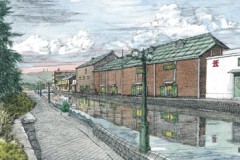 © Yoshida Keiji 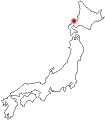
Waterfront warehouses, Otaru (Keiji)The northern island of Hokkaido was only opened up in the Meiji era (late 19th century), and Otaru became an important port then. This canal provided shelter for ships to unload even in rough weather, and the preserved warehouses date back to that time. They were modelled on building techniques imported from the West. They appear to be brick-built, but are actually timber-framed, with brick and stone outer cladding. Born in 1930, in Gifu Prefecture, Yoshida Keiji graduated in 1952 from what is now the Tokyo University of the Arts, and trained as an architect. He was a joint founder of Rengousekkeisha Ichigaya Architects in Tokyo, and in addition has held academic appointments and written widely, particularly on wooden building construction and aspects of townscape. He is active in the movement to preserve the traditional Japanese townscape, which features in his many "travel sketches," together with views from wider travel around the world. Yoshida is his family name.
 Permanently unavailable Permanently unavailableAn Epoch puzzle: 1000 pieces; 750 x 500 mm (30" x 20") Code: E11321 (11-321 on package) Retail price ¥3000 |
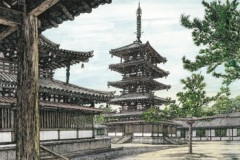 © Yoshida Keiji 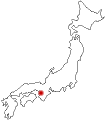
Hōryū-ji, the oldest pagoda (Keiji)The temple of Hōryū-ji, near Nara, includes what are thought to be the oldest surviving wooden buildings in the world — the central pillar of the pagoda having been dated at over 1400 years old. The artist gives us a direct view of the architectural intricacy of the buildings, which makes for a texturally rich puzzle. 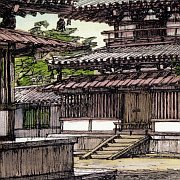 Born in 1930, in Gifu Prefecture, Yoshida Keiji graduated in 1952 from what is now the Tokyo University of the Arts, and trained as an architect. He was a joint founder of Rengousekkeisha Ichigaya Architects in Tokyo, and in addition has held academic appointments and written widely, particularly on wooden building construction and aspects of townscape. He is active in the movement to preserve the traditional Japanese townscape, which features in his many "travel sketches," together with views from wider travel around the world. Yoshida is his family name.  Permanently unavailable Permanently unavailableAn Epoch puzzle: 1000 pieces; 750 x 500 mm (30" x 20") Code: E11341 (11-341 on package) Retail price ¥3000 |
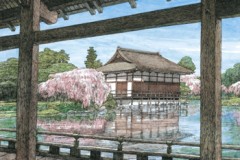 © Yoshida Keiji 
Heian shrine, Kyoto (Keiji)The classic view of the Kihin-kan ("guest residence") in the gardens of the Heian shrine in Kyoto. This site was built relatively recently, in 1895, on the site of the Emperor's palace in Kyoto, commemorating 1100 years since the capital moved there from Nara. The artist has chosen the season carefully, the weeping cherry blossom perfectly setting off the buildings. 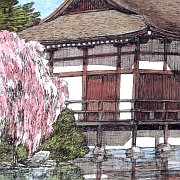 Born in 1930, in Gifu Prefecture, Yoshida Keiji graduated in 1952 from what is now the Tokyo University of the Arts, and trained as an architect. He was a joint founder of Rengousekkeisha Ichigaya Architects in Tokyo, and in addition has held academic appointments and written widely, particularly on wooden building construction and aspects of townscape. He is active in the movement to preserve the traditional Japanese townscape, which features in his many "travel sketches," together with views from wider travel around the world. Yoshida is his family name.  Permanently unavailable Permanently unavailableAn Epoch puzzle: 1000 pieces; 750 x 500 mm (30" x 20") Code: E11342 (11-342 on package) Retail price ¥3000 |
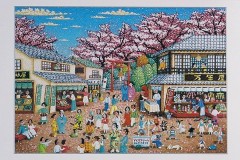 © Toshikazu Yoshida Springtime (Yoshida)It's cherry blossom time again! This festive scene is set at the entrance to a shrine (marked by the torii arch), which is doubtless a good spot for a picnic under the falling petals.  (Note that the white frame is part of the puzzle.) Born in Tokyo in 1963, the artist portrays nostalgic glimpses of the world of his childhood. In addition to being a prolific illustrator, he is a keen mountaineer in his spare time. He paints in a distinctive pointilliste style: closely-packed blobs of bright colour. Yoshida is his family name - he does not seem to sign his pictures.  Permanently unavailable Permanently unavailableAn Apollo puzzle: 1000 pieces; 750 x 500 mm (30" x 20") Code: P10537 (10-537 on package) Retail price ¥2800 |
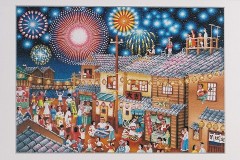 © Toshikazu Yoshida Summer fireworks (Yoshida)All the elements of a traditional festival (matsuri) are here - the fireworks, of course, but also the street sellers of various delicacies (including beer!), and lots of people in their summer wear. The scene is being watched by a guitarist, perched precariously on the window ledge. 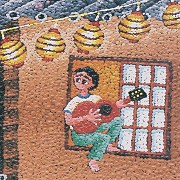 (Note that the white frame is part of the puzzle.) Born in Tokyo in 1963, the artist portrays nostalgic glimpses of the world of his childhood. In addition to being a prolific illustrator, he is a keen mountaineer in his spare time. He paints in a distinctive pointilliste style: closely-packed blobs of bright colour. Yoshida is his family name - he does not seem to sign his pictures.  Permanently unavailable Permanently unavailableAn Apollo puzzle: 1000 pieces; 750 x 500 mm (30" x 20") Code: P10538 (10-538 on package) Retail price ¥2800 |
 © Matsumoto Tadashi 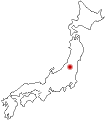
Paddy field reflections (Matsumoto)The local train passes through the rice fields, not long after leaving Aizu Wakamatsu... This single-track, non-electrified line, joining East to West across Japan's mountain backbone was only completed in 1971 from Aizu Wakamatsu (Fukushima) to Koide (Niigata). It has escaped "rationalisation", because heavy winter snowfall closes the only road alternative. Born in Kanagawa in 1973, Matsumoto Tadashi took an arts degree from Tohoku University, before pursuing a career in illustration. He specialises in the railway scene, and his work has appeared both in specialist train magazines and general travel literature. He combines attention to engineering detail with a warm evocation of rural charm.  Permanently unavailable Permanently unavailableA Yanoman puzzle: 1000 pieces; 750 x 500 mm (30" x 20") Code: Y101145 (10-1145 on package) Retail price ¥3000 |
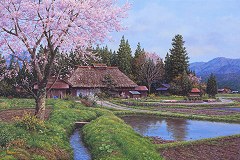 © Kaneko Tohikazu 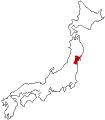
Spring breeze (Tohikazu)Petals flutter down like snowflakes, in this painting of a rural scene in Miyagi, northern Japan (we're not given the precise location). The painter Kaneko Tohikazu has a style of unassuming simplicity, yet contrives to include all the classic elements of the Japanese rural scene. He is known as a "painter of thatch roofs", but also faithfully reproduces the gently disorganised scattering of outhouses with their galvanised iron coverings. An array of familiar trees and shrubs, and the retaining walls of piled rocks fringe the paddy fields - mostly dry from the winter, but water from the conduit in the foreground has flooded one small area, as if by accident.  Permanently unavailable Permanently unavailableA Yanoman puzzle: 1000 pieces; 750 x 500 mm (30" x 20") Code: Y10939 (10-939 on package) Retail price ¥2500 |
500 pieces
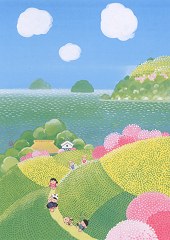 © Ikehara Shôji Island pilgrimage (Ikehara)The "pilgrimage" of the title no doubt refers to the famous tour of 88 Buddhist temples on the artist's home island of Shikoku. Children lead the way for a couple of henro (pilgrims) on this path around the headland. 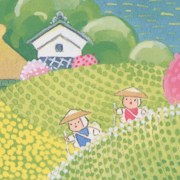 A Web search for "Shikoku pilgrimage" will find many accounts in English: here's one by Jeff Hackler Born in Kagawa Prefecture (Shikoku) in 1939, Ikehara is an artist specialising in illustration for children's story book, but whose work has also appeared in TV manga versions of traditional tales, and on postage stamps. His style is simple, but effective. He signs his pictures with a hand-drawn "seal", which is hard to decipher, but looks like the second character of his given name.  Permanently unavailable Permanently unavailableAn Epoch puzzle: 500 pieces; 380 x 530 mm (15" x 21") Code: E06023 (06-023S on package) Retail price ¥2000 |
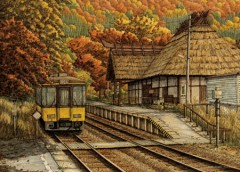 © Matsumoto Tadashi 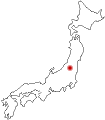
Hometown tints (Matsumoto)A rare sight anywhere: a station with a thatched roof. This station serves Yunokami Onsen, a resort evocative of the Edo period before the modern age, and famed for autumn colours. This is on the Aizu Railway, running north-south through the mountains along the old Nikko Road. Born in Kanagawa in 1973, Matsumoto Tadashi took an arts degree from Tohoku University, before pursuing a career in illustration. He specialises in the railway scene, and his work has appeared both in specialist train magazines and general travel literature. He combines attention to engineering detail with a warm evocation of rural charm.  Permanently unavailable Permanently unavailableA Yanoman puzzle: 500 pieces; 530 x 380 mm (21" x 15") Code: Y05914 (05-914 on package) Retail price ¥2000 |
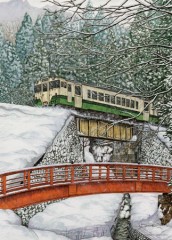 © Matsumoto Tadashi 
Winter scene (Matsumoto)A striking composition, reminiscent of a classic woodblock print... near Yanaizu on the Tadami line The artist tells how he took the train to Yanaizu, left the station, and found this footbridge providing a splash of colour against the winter monotone: it was then only a question of waiting for a train to pass. This single-track, non-electrified line, joining East to West across Japan's mountain backbone was only completed in 1971 from Aizu Wakamatsu (Fukushima) to Koide (Niigata). It has escaped "rationalisation", because heavy winter snowfall closes the only road alternative. Born in Kanagawa in 1973, Matsumoto Tadashi took an arts degree from Tohoku University, before pursuing a career in illustration. He specialises in the railway scene, and his work has appeared both in specialist train magazines and general travel literature. He combines attention to engineering detail with a warm evocation of rural charm.  Permanently unavailable Permanently unavailableA Yanoman puzzle: 500 pieces; 380 x 530 mm (15" x 21") Code: Y05915 (05-915 on package) Retail price ¥2000 |
300 pieces
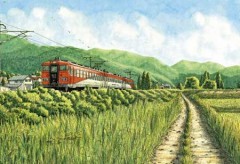 © Matsumoto Tadashi 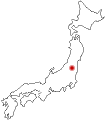
Following wind (Matsumoto)A peaceful summer scene, as the train passes through the gentle landscape around Lake Inawashiro. This is the West Ban'etsu line running east-west across northern Honshu, and principally serving the historic town of Aizu Wakamatsu. Born in Kanagawa in 1973, Matsumoto Tadashi took an arts degree from Tohoku University, before pursuing a career in illustration. He specialises in the railway scene, and his work has appeared both in specialist train magazines and general travel literature. He combines attention to engineering detail with a warm evocation of rural charm.  Permanently unavailable Permanently unavailableA Yanoman puzzle: 300 pieces; 380 x 260 mm (15" x 10") Code: Y03700 (03-700 on package) Retail price ¥1400 |
- 18 puzzles shown
- Explore the attics: complete list of deleted puzzles

 This puzzle has smaller pieces than the standard size.
This puzzle has smaller pieces than the standard size.